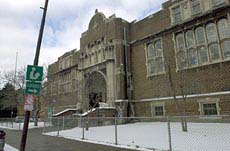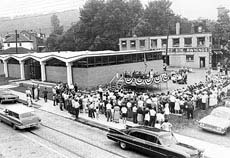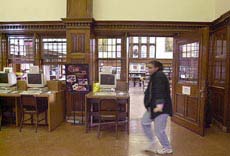
Carnegie’s Library Legacy
The Carnegie struggles with honoring the past while serving the present and future
Sunday, March 02, 2003
By Patricia Lowry, Post-Gazette Architecture Critic
From Fiji to Florida to Fresno, Calif., Andrew Carnegie built 2,509 libraries between 1881 and 1917, mostly in America, the British Isles and Canada. To this day, Carnegie’s free-to-the-people libraries remain Pittsburgh’s most significant cultural export, a gift that has shaped the minds and lives of millions.

The Homewood library opened at the corner of Hamilton Avenue and Lang Street in 1910. Today the branch becomes the first to be rehabilitated in Carnegie Library of Pittsburgh's $40 million systemwide renovation, libraries also must accommodate information available through electronic media. New computer stations are among the updates in the Homewood makeover, which restores major architectural elements while sacrificing others considered less significant. (Joyce Mendelsohn, Post-Gazette)
From the monumental libraries of the Monongahela Valley steel towns to the smaller branch libraries in Pittsburgh neighborhoods, the Carnegie library buildings of Western Pennsylvania also have a national significance — and for some, an uncertain future.
In Pittsburgh, whether to bring these beloved, iconic but aging buildings into the 21st century or leave them behind is a question the city soon will face, as Carnegie Library of Pittsburgh reinvents itself with an emphasis on customer service and satisfaction.
Last fall, when library director Herb Elish asked City Council to give the library the option to buy the city-owned buildings it occupies, it wasn’t because he has a real estate fetish. While Elish doesn’t want to talk publicly about which libraries eventually may have new uses, he acknowledges that three of the older buildings could be sold, although not without community input.
The man who seems destined to have the biggest impact on Carnegie’s Pittsburgh libraries since the steelmaker himself is also a former steel executive, CEO at Weirton Steel Corp. from 1987 to his retirement in 1995.
Elish said he took the library job because he thinks libraries can “raise up people’s consciousness,” leading to “greater literacy, better jobs and rich, useful lives.” He wants each library, old or new, to be a place “people want to come to, think is enjoyable, get a lot out of and have fun at, because at the end of the day, it’ll just make their lives better.”
Elish’s $40 million systemwide makeover got under way last month when work began on the historic Homewood library. Renovations to the Brookline, Squirrel Hill and Woods Run branches and the central library in Oakland also will happen over the coming year. To design the plans, Elish hired five small Pittsburgh architecture firms known for imaginative, even provocative work, then matched them with the projects for which they seemed most suited. The idea, Elish said, was “to get a lot of ferment of ideas, with architects talking to each other about how things should be designed.”
For the 19 city libraries expected to be renovated over the next five to seven years, the goals are the same: to create “fully modern buildings” that are air-conditioned and accessible for wheelchairs and baby strollers, have community meeting rooms and spaces for teens, and give “each neighborhood a space and an image that is new and that the community can be proud of,” Elish said.
“Economic development can happen around a library because libraries attract a lot of people,” he added. “We think that libraries can be symbolic of belief in and support of the neighborhoods. It’s one of the reasons that we, as a policy matter, said we weren’t going to end library service in any neighborhood where it currently exists. We can be a force to help bring that neighborhood back.”

The Woods Run branch library, shown on opening day, July 8, 1964, is scheduled for interior renovation this year as well as for construction of a drive-through drop-off for books.
Let there be libraries
Carnegie opened his first public library in his hometown, Dunfermline, Scotland, in 1883. Rather than his name, he had a motto — “Let there be light” — carved within the Gothic-arched entrance; nevertheless, the three-story, turreted stone castle of a building announced that the weaver’s son had done rather well in America.
As many full-blooded Pittsburghers know, Carnegie erected his first public library in this country in his adopted hometown, Allegheny City, where as a youth he drank from the sweet chalice of knowledge in the home of Col. James Anderson, who opened his personal library on Saturday afternoons to the neighborhood’s working boys.
Braddock’s library had opened a year earlier, in 1889, but not as a publicly supported library. Braddock’s was fully funded by the Carnegie Steel Co. and governed by its officials — giving both the Braddock and Allegheny libraries bragging rights to firsts. Homestead’s library followed in 1898, Carnegie’s in 1901 and Duquesne’s in 1904.
While some of Carnegie’s steelworkers literally and figuratively had no time for his libraries, preferring the saloon and the lodge, other men and their wives learned English there at night and made good use of the libraries’ music halls, gyms, bowling allies, swimming pools and baths.
And their children and their children’s children embraced them. Monumental entrance arches, grand staircases, marble floors and hooded fireplaces transported girls and boys to another world. The medieval French chateau and the Renaissance palazzo, set down amid fire-breathing furnaces, clapboard houses and courtyards strung with laundry, gave hope to children in the first half of the 20th century that life wasn’t all blood, sweat and soot. Best of all, the shelves were lined with books, and you could carry your dreams right out the front door.
For the Allegheny library, Washington, D.C., architects Smithmeyer & Pelz drew not from the lavish, ornate classicism of their 1873, Renaissance-style design for the Library of Congress but from Boston architect Henry Hobson Richardson’s smaller, asymmetrical, towered New England libraries in rusticated stone.
Smithmeyer & Pelz gave the Allegheny City library foyer a wide, white marble staircase leading to the second floor, much as patrons would have found in one of the homes on nearby Ridge Avenue. Beyond the entrance hall was the “delivery room,” where books fetched by librarians from closed stacks were dispensed to readers. At one end of the room, an early photograph shows, Andrew Carnegie’s benevolent gaze greeted them from above a roaring fireplace. To the right of the delivery room was the men’s reading room and, in a small alcove, the women’s reading room.
There was no children’s room in the Allegheny City library — that innovation belongs to the Lawrenceville library of 1898 — but for adults and children alike, the Allegheny library’s “homey touches encouraged readers to think that the hierarchy was sustained not just by economic power but by mutual love and respect, as in an extended family,” writes architectural historian Abigail Van Slyck in “Free to All,” her 1995 book on Carnegie libraries. “Library users might then look upon Carnegie as a rich uncle, who deserved respect, obedience and affection, and whose affection in return precluded any class resentment.”
Carnegie still presides over the library’s former delivery room, but not from over the fireplace mantel. A 1970s renovation gutted most of the original interior. Today, as Pittsburgh’s Allegheny branch, the library is bright, white, modern and actively used. But it has lost its grand staircase, fireplace and all of its domestic and hierarchical connotations. Uncle Andy’s portrait hangs unceremoniously above a periodicals rack, flanked by the men’s and women’s bathrooms.
Visitors will have little trouble stepping back a century in the Braddock and Carnegielibraries, which have accommodated new technology without sacrificing the cozy comfort of their historic interiors. In both locations, Carnegie’s portrait still hangs over the fireplace.
Like the Andrew Carnegie Free Library of Carnegie, the Carnegie Library of Homestead is majestically sited near a hilltop, overlooking the town and the river valley. Opened in 1898, it has seen some interior alterations over the years — for one thing, the fireplace gave way to bookshelves — but it’s still standing and serving its community — more than can be said for the 1904 library in nearby Duquesne. Rivaling the Homestead and Carnegie libraries in size and setting, the Duquesne building was demolished in 1968 to make way for a school district building that was never built. The library site is now Library Court, a cul-de-sac of ranch houses.

A distinguishing feature of Pittsburgh's Carnegie library branches is the wood and glass partitions between rooms, which allowed a single librarian to watch over the entire facility. At the Homewood library, shown here with a view from the lobby into the children's reading room, sections of the partitions will be removed to create better flow between the lobby and the adult and children's reading rooms. (Joyce Mendelsohn, Post-Gazette)
A late bloomer
Pittsburgh also was getting in on the library boom, even if it was a little late to the party. In 1881, the same year Carnegie began his first library in Dunfermline, he offered Pittsburgh $250,000 for a library if the city would provide the land and $15,000 annually for its maintenance. It was an offer the city could and did refuse, believing it was not a state-sanctioned use of public money.
By 1887, with the city assured by the state legislature that a public library was an appropriate use of tax funds, Pittsburgh officials told Carnegie they were ready to accept his gift. In 1890, the philanthropist expanded his original offer to $1 million for a conjoined central library and art museum, as well as branch libraries in the neighborhoods, which Carnegie came to view as more important in elevating the working class. Eventually, his gift to Pittsburgh would total $1,160,614.
Twelve years after the initial offer, construction began on the central library and museum in Oakland, following a design competition won by Longfellow, Alden & Harlow of Pittsburgh and Boston. But not long after it opened, the library was found to be woefully inadequate. For one thing, everybody forgot about the kids.
“So little thought was given to children as library users before 1895 that no provision was made for them,” library director Ralph Munn wrote in 1969. The library also had no room for scientific and technical books. An addition, opened in 1907, solved both problems, as well as one that had vexed Carnegie for more than a decade. The twin towers that flanked the music hall — “donkey ears,” he called them — were demolished in the expansion.
Today, Elish said, the problem with the main library is its organization: “You sort of need a secret handshake to find your way around.”
Books are shelved in unpredictable locations and departments, and even once visitors identify where a book is, they can have a hard time finding it.
To remedy that, Friendship-based EDGE architecture is working with librarians and South Side’s MAYA Design to reorganize and, as MAYA likes to put it, “tame the complexity.” MAYA analyzed why people couldn’t find what they were looking for and discovered that, in a library with millions of items spread over a labyrinth of rooms, “wayfinding” is an issue right up there with book-finding.
EDGE’s $3.1 million design is still being refined and won’t be ready for public review for a couple of months.
“We’re looking to make an environment that’s a destination because it’s entertaining, it’s informative and it’s an exciting place to be — and not do anything that violates the existing architecture and character,” said EDGE architect Gary Carlough.
Work could begin as early as mid-summer, but Dunham said it’s too soon to say how long the renovation might take.
While the branch libraries have gone or will go through a neighborhood input process in their renovation planning stages, for the main library, that process will happen in public hearings before City Council, a requirement for any project in the main library with more than a $1 million budget.
A first for Lawrenceville
After impressing Carnegie with the quality of their work — and their ability to stay on budget — Longfellow, Alden & Harlow, who also completed an 1893 addition to the Braddock library, would go on to design the Homestead and Duquesne libraries and, as Alden & Harlow, eight Pittsburgh branches, as well as libraries in Oakmont, Erie and, in Ohio, at Salem and Steubenville.
The first of the Pittsburgh branches, completed in 1898, was in Lawrenceville, the densely built neighborhood of factories and brick rowhouses. The library was built on residential Fisk Street, in the heart of the neighborhood but not on the main drag.
No more would Carnegie build big, homey castles, as he had done in the towns with which he had personal associations. Correspondingly, Alden & Harlow “divested their libraries of the domestic connotations that had appealed to the paternalistic philanthropist of 1880, and allowed the buildings to convey their public nature to prospective readers,” Van Slyck writes. The branch libraries would be classical and symmetrical, and done in brick to better fit their surroundings.
With a then-revolutionary open-shelf policy in all branches, the small libraries were planned so one librarian could oversee the entire operation. That dictated the interior plans of all the Pittsburgh branches, beginning at Lawrenceville and continuing through West End and Wylie Avenue (1899), Mount Washington and Hazelwood (1900), East Liberty (1905), South Side (1908) and Homewood (1910).
Lawrenceville was “the most innovative and important of these Pittsburgh branch libraries,” a design that “broke with Richardsonian precedent in both style and plan,” writes Margaret Henderson Floyd in “Architecture After Richardson,” her 1994 book on Longfellow, Alden and Harlow.
Located just beyond the lobby, the circulation desk — no longer a delivery desk — took center stage in Lawrenceville, flanked by turnstiles that admitted readers to the open stacks one at a time, under the librarian’s watchful eye. To thwart thievery, the stacks were arranged in a radial pattern. On each side of the lobby were a general reading room and, for the first time in a library anywhere, a room for children, many of whom were learning English as a second language or had immigrant parents. The reading rooms were separated by walls that became glass partitions above waist level — the better to see you with, my dear.
Despite such controlling devices, the library was well used. Over a six-week period in 1925, for example, a YWCA study of the Lawrenceville library found that 190 young women between 18 and 25 requested 736 books, 590 of which were fiction; the most popular writer was Pittsburgh’s own Mary Roberts Rinehart.
The Lawrenceville design — a rectangle with a semicircular rear projection to accommodate the radial stacks — was repeated at East Liberty, but economy forced other branches into a mostly rectangular plan, with shelves lining the perimeter walls.
The plan developed here became a model for Carnegie libraries around the world, and, in 1911, was included in a design advisory pamphlet issued by Carnegie’s secretary, James Bertram, who reviewed the plans of all Carnegie libraries after 1908.
The East Liberty library, serving the wealthy East End community, was the largest of the branches when it opened, but it was demolished in the late 1960s to accommodate the city’s ill-fated urban renewal plan for the commercial district.
The Wylie Avenue branch moved from its historic building to a new location in 1982, because demolition of the Lower Hill neighborhood in the 1960s had left it at one end of its former service area. The building now houses a mosque.
But the six branches that survive as libraries — Lawrenceville, West End, Mount Washington, Hazelwood, South Side and Homewood — have a remarkably high degree of integrity, inside and out.
A dwindling legacy
By 1917, Carnegie had invested $68,333,973 in libraries here and abroad, equivalent to about $966 million today. Of the 1,689 Carnegie libraries built in America, at least 350 have gone on to other uses, writes Theodore Jones in his 1997 book, “Carnegie Libraries Across America: A Public Legacy.” Another 259 have been razed or destroyed by fire or other natural disasters — 100 in the 1960s, 47 in the 1970s, 12 in the 1980s, a downward trend fueled by the historic preservation movement.
But that trend, Jones writes, has been reversing since the 1990 passage of the Americans with Disabilities Act.
“Public libraries are moving out of their original Carnegie buildings more frequently than ever,” he writes. According to 1991 and 1996 surveys, of the 350 or so libraries that have been reused, 60 were still libraries in 1991.
Elish has said he would consider selling a branch building if it proves too expensive to upgrade or is in a difficult location that lacks parking, but he is keeping an open mind and hopes Pittsburghers will do the same. He also wants to hear from the community.
“We don’t want to get in a position of saying, ‘We don’t want to be in [the old] building’ and have the community rise up in arms” and not use the new building, Elish said. But, he adds, “Part of this is a cost problem. If you find that the renovation of a building is prohibitive compared to what you’re going to get in a new building, you need to lay out the costs and talk about them. You can’t make irresponsible decisions.
“I just think by the end of all of the conversations about this, that good sense will prevail on both sides. We will learn from each other and reach a conclusion together.”
It’s a dialogue that should engage everyone who has a stake in the future of Pittsburgh’s archetypal neighborhood libraries.
